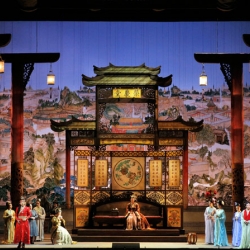OPERA REVIEW
Manami Hattori-Fallen is the quintessential Butterfly, delicate as the strokes in a Japanese painting.
In OperaLancaster's opening night presentation at Franklin & Marshall College's Roschel Performing Arts Center of Giacomo Puccini's "Madama Butterfly," she looked and moved exactly as Lt. B.F. Pinkerton describes her: " … light as a feather … And like a butterfly, hovers and settles."
Puccini has been criticized for writing heavy music for his 15-year-old heroine, Cio-Cio-San, such that the role is sung traditionally by portly women with big soprano voices.
Hattori-Fallen proved it isn't necessary to have a large voice to carry Butterfly through her emotionally charged scenes.
She sang "Un bel di" (One fine day) without pushing her voice but still conveying feelings of urgency and desperate hope that Pinkerton, the U.S. Navy officer who married then left her, will return. Hattori-Fallen has the voice that one would expect of a petite teenager.
On the other hand, Celeste Siciliano proved it isn't necessary to be small to portray vulnerability. At the Wednesday dress rehearsal, she tried hard to create the illusion of fragility by moving very slowly and making tiny gestures.
However, she did not hold back her voice. And it is precisely this strong voice - rich with passion and pathos - that made me believe. Halfway through the second act, it didn't matter anymore what she looked like. Siciliano was Butterfly.
"Butterfly" is a soprano's opera - she is on stage and constantly singing almost from start to finish - but Puccini did not neglect Pinkerton. Besides two tenor arias, he wrote an 11-minute throbbing love duet that showed off Benjamin Sloman's exciting laser-point high notes while singing with Hattori-Fallen; and Adam Cromer's magnificent top spin, with Siciliano.
The mezzo-sopranos, Hyo Na Kim on opening night and Sarah Kraus at the dress rehearsal, provided exceptional vocal and acting support as Butterfly's servant, Suzuki. So did the baritones Ted Labow (singing with Hattori-Fallen) and Michael C. Anderson (with Siciliano) as Sharpless, the American consul.
Music director and conductor Richard Anderson elicited precise sounds from the 20-piece orchestra. His affinity with Puccini's music was evident in the overture to Act 3 as well as in the beautifully sung Humming Chorus that accompanies Butterfly's long night of waiting for Pinkerton.
Artistic director John Darrenkamp knows how to play up tragic endings. Just before Butterfly kills herself, she hugs her 3-year-old son and tells him to "look at me so you'll remember your mother's face" in the anguished aria, "Tu, tu, tu" (You, you, you). She then directs him to "go, play, play."
A common version of the suicide scene has Butterfly killing herself behind a screen. But Darrenkamp placed Hattori-Fallen and Siciliano stage center, facing the audience in a kneeling position. It was disturbing to see their eyes staring blankly as they slashed their throat.
This production of "Butterfly" doesn't spring surprises on opera-goers. As with previous operas Darrenkamp directed for OperaLancaster, he does not move "Butterfly" to another time period or economize with an abstract set.
The beautiful set was designed by Benjamin Mountz according to specifications in the libretto. It shows a Japanese house with sliding screens with a view of Nagasaki's hills in the background.
Darrenkamp will not experiment with favorite operas. And wisely so.
Editor's note: This review is based on Cast A's Thursday performance and Cast B's Wednesday dress rehearsal. "Butterfly" will run Saturday at 2 and 7:30 p.m. and Sunday at 2 p.m. Tickets will be available at the door an hour before performance.

 < Opera News > La Traviata, New York City Mannes Opera
< Opera News > La Traviata, New York City Mannes Opera










